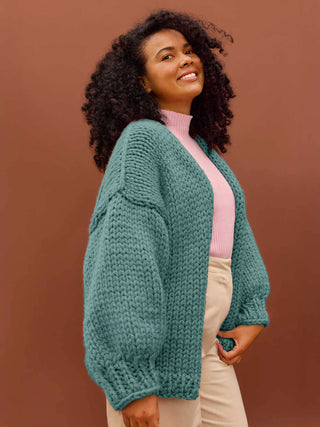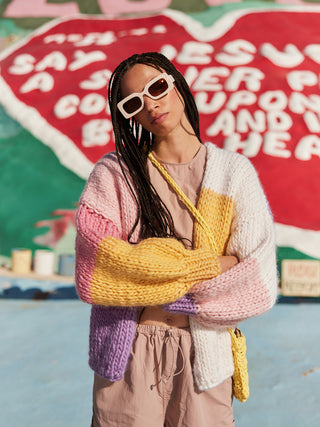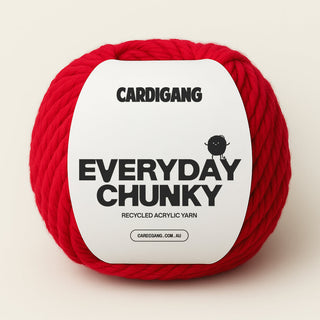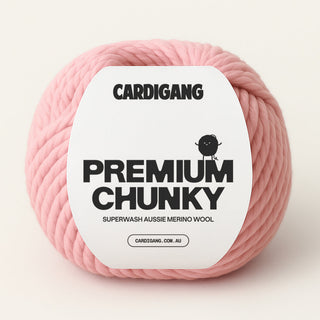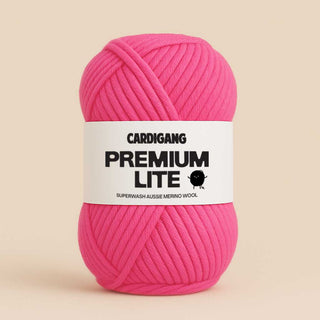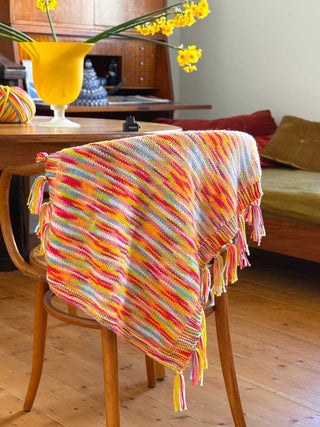A step by step guide to knitting the gorgeous Miranda Cardi.
Ever gotten half way through a project and thought “Hang on, am I even doing this right?”
We have 🙋♀️
That’s why we’ve created these step by step guides to walk you through the knitting process.
THE BASICS
If you're a total knitting newbie - WELCOME! 👋 Learning to knit can feel a bit like learning code. We've stripped away the complicated jargon and tried to keep things really simple so even the newest knitter can master the skill 🧶
Before we get started on the pattern it’s a good idea to learn the basic stitches you’ll need to complete your masterpiece. You can use the yarn that came in your kit to practice with. The video below covers every technique you'll need to learn (spoiler - there's only 5!). Learn how to cast on, do a knit stitch, a purl stitch and put them together to create a rib stitch, lastly, we learn casting off. Once you've got these mastered you'll find this pattern is a cinch!
💭 For more detailed videos of each technique, head down a little further where we've got specific videos for each stitch type.
🚨 While the Miranda is knitted in Mohair (not Merino as shown in the videos) the techniques are exactly the same 🤓 👩🎓
YOU'VE GOT THIS ⚡️💪
Remember learning a new skill can be a little challenging at first, and you’re bound to find yourself making some mistakes along the way. But as with learning anything, your brain and your hands slowly start to get the hang of it, muscle memory is created, and soon the thing you found tricky/daunting/scary is like second nature!
If you get stuck, reach out to us and we'll give you a (virtual) hand! 😎
TEST YOUR TENSION
Before you start your project, you should make sure your tension (how tightly or loosely your knitting is) is juuuust right 🥣 We do this by knitting a “tension swatch”. It's a bit like goldilocks, if the tension is too tight, your piece will be too small, and if it's too loose it may not hold its shape and might be too big.
If done correctly, your 10x10cm knitted swatch should be 8 stitches high and 11 rows wide when knitted on 12mm needles. To test this, jump on your 12mm needles and cast on around 16 stitches, then knit in stockinette stitch (row 1 knit, row 2 purl) for around 12 rows. Then use the card that came in your kit to measure 10x10cm and count your stitches and rows to make sure you're knitting at the correct tension.
WHAT YOU’LL NEED
Your kit comes with everything you need to knit your masterpiece.
- 10mm circular needles
- 12mm circular needles
- Chunky Mohair yarn
- Darning needle
CHUNKY MOHAIR
We knit our Chunky Mohair double strand. This means you have two strands on the go at once. To start with, we suggest pulling one tail from one ball and one from another. As you get more confident you can work with one ball if you like, you'll just use both ends of the ball.
💭 🚨 Now, a little word of caution when knitting with two strands. It's a lot easier to put your needle through your stitch in the wrong place when you're knitting with two strands. If you do this you'll end up with more stitches on your needle than you've cast on 🤯 We recommend counting your stitches every few rows as you knit to make sure you haven't added any rogue stitches. If you have, and it's picked up quickly, you can knit two stitches together on the next row to get back to your correct number of stitches for the piece.
Here's what knitting double strand looks like when you cast on.


THE TECHNIQUES YOU’LL MASTER
CASTING ON
Casting on is the first step in any project. It's the term we use for getting the wool onto our needles! We recommend using the two-needle technique as it's one of the simplest methods. Two-needle cast on uses your two needles (surprise!), starting with a slip knot on your left needle, each stitch is knitted to form a new loop and this loop is then added to your left needle. You repeat until you’ve made the desired number of stitches.
💭 Casting on, like many things in knitting, can be done in a number of ways - our suggestion is a simple technique but you can pick any that’s right for you.
KNIT STITCH
This handy little stitch makes up the backbone of most knitting patterns. Each knit stitch looks like a little ‘v’.
PURL STITCH
The second most common stitch, purl stitches look like little bumps (or purls!). You knit a knit stitch with your yarn tail at the back of your work and your needle going into the back of the stitch, the purl is the opposite, so your yarn tail is at the front of your work and your needle goes into the front of the stitch.
RIB STITCH
A rib stitch is a textured pattern usually used on the cuffs and necks of jumpers. It’s made by alternating knit and purl stitches in the same row, then knitting the same stitch sequence in the next row.
CASTING OFF
To cast off, knit two stitches then slip the first stitch on your right needle back over the second stitch and off the needle. You’ll have one stitch left on your right needle. Knit another stitch so you’ve got two stitches on your right needle and then slip the first stitch off. Continue to the end of the row. When you’ve got the last stitch on your right needle, cut the yarn and thread this through the final stitch to secure. To see casting off in action watch our "Master The Basics" video above.
REDUCING STITCHES
We reduce the number of stitches on our needle by knitting or purling some stitches together. This simply means we put our right needle into the second stitch on your left needle and collect both the first and second stitch and knit them as you would a single stitch.
PICKING UP STITCHES
You'll need to pick up stitches around the neckline of the cardi so you can knit the ribbed button band.
SEWING IT TOGETHER
You'll sew your masterpiece together by laying the pieces flat and joining them one at a time.
Step 1:
Lay your front and back pieces on a flat surface, the right sides facing you.
Step 2:
Sew the shoulder panels of the front panels to the back panel using the invisible seam technique, and leaving the hole in the middle for the open front of the cardi. It's best if you work from the edge of the piece and sew inwards.
Step 3:
Time to attach the sleeves to the body. Make sure the middle of your sleeve is lined up with the shoulder seam. This will ensure the seam of your sleeve is right under your armpit, not half way around your arm! Once you've made sure it's all lined up, sew the sleeves to the shoulders.
Step 4:
Fold your cardi in half long ways with the wrong sides facing each other, we're going to sew it together using a Mattress Stitch, from the arm cuff all the way up the arm to the armpit, then down the side seam to the bottom of your cardi. And then repeat this on the other side.



